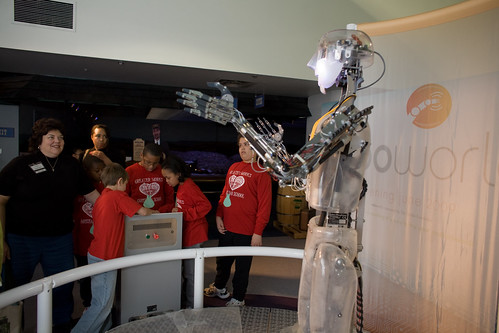Carnegie Mellon teaches about robots; children hit random buttons and pretend to learn something.
I have not visited the Pittsburgh university, but the Robot Hall of Fame appears to be part of a growing focus on robotics at their Science Center. Just about this time last year, it was announced that "roboworld" would provide a permanent educational display about artificial intelligence and other such lovable automatons. As far as I can tell, the Robot Hall of Fame is nestled among these displays.
Since it was founded in 2003, the hall has inducted 26 robots, with eight arriving in last year's picks. Because scientists want to have fun too, the jury for choosing the inductees is made up of an international hodgepodge, with members ranging from late sci-fi writer Arthur C. Clarke to Steve "The Woz" Wozniak, a lowly co-founder of Apple. And these are serious deliberations, too, with jury teleconferences to discuss the relative merits of each nominee. You didn't hear this from me, but apparently Dr. Ruzena Bajcsy, a Berkeley electrical engineering and computer science professor, once exchanged blows with Anthony Daniels, the actor who played C-3PO, over the question of whether or not Agent Smith from the Matrix movies constitutes a robot.
 Agent Smith grimaces upon learning that he was barred from consideration in the 2008 induction for stuffing the ballot box.
Agent Smith grimaces upon learning that he was barred from consideration in the 2008 induction for stuffing the ballot box.As it stands right now, the count is tied at 13 each for fictional and non-fictional robots. Of course, when you put them side by side, the non-fictional bots leave something to be desired.
Non-Fiction
- Three Mars rovers (Pathfinder, Spirit, and Opportunity)
- Two robotic manufacturing arms (Unimate and SCARA)
- A medical system (DaVinci Medical Robot System)
- A shuffling, faceless humanoid (ASIMO)
- A robot named after its jerky motions rather than its groundbreaking ability to reason (Shakey)
- Another bot with an unflattering nickname and a groundbreaker in the development of mobility (Railbert Hopper)
- A self-steering minivan (NavLab 5)
- A plastic puppy (AIBO)
- A vacuum cleaner (Roomba)
- A Lego toy line (Mindstorms)
Fiction
- Three service drones assisting a rogue botanist in his attempt to save Earth's surviving forests (Huey, Dewey, and Louie)
- Two droids who helped defeat a galactic Empire (R2-D2 and C-3PO)
- An android and chief operations officer on board a starship (Lt. Commander Data)
- A killer cybernetic abomination turned super-strong cybernetic bodyguard (T-800 Terminator)
- A killer AI spaceship system (Hal-9000)
- A hulking, shiny warning against nuclear war (Gort)
- A metallic bourgeois doppelganger (Maria, of Metropolis)
- A synthetic replacement child (David, of A.I.)
- Another child-bot, with superpowers! (Astro Boy)
- A bulky automaton who, if pop culture is to be believed, does nothing but shout that danger is about (Robby the Robot)
OK, so maybe scientists have some of those fictional creations beat, but for the most part they're getting outclassed. At least the non-fictional choices carry more weight, given the fact that they actually exist. Shakey, for example, looks like your standard ugly-but-functional creation but had rudimentary language capabilities and was able to figure out how to meet simple given instructions on its own. The Spirit and Opportunity rovers, meanwhile, are on another planet. And they're still working to gather information from Mars, even if they're almost as old as the Robot Hall of Fame itself. The fictional bots, meanwhile, are honored more for their place in introducing the robotic concept into popular culture. Though given the induction of the T-800 and HAL-9000, they're already dipping into the homicidal robot category just a bit; both of these creations started off as bad guys, then returned as protagonists in the sequel.
Spoiled a perfectly good ceremony by saying who all the inductees would be through 2029.
Carnegie Mellon has been a little lax in updating the hall's website, so the last detailed update only discusses the 2008 bots. Meanwhile, the nomination process allowed on the sites shows both the wide range of pop culture AI out there and puny human intelligence, dropping towards a point where ASIMO will be able to beat us by his ability to maneuver stairs. For example, Lieutenant Commander Data of the starship Enterprise has garnered a two percent favorable rating (the sixth highest of the list) from users despite the fact that he was added to the Hall of Fame two years ago; other nominations show numerous repeats or requests for bots already honored. The top contenders among the public are currently the cannon-wielding video game character Mega Man (who I always thought was more of a cyborg) and surly 30th century suicide booth manufacturer Bender Bending Rodriguez of Futurama.I'm all for robots having their own hall of fame, and I think this will have a rather nice unintended side effect. There are a staggering number of fictional bots out there. Futurama alone can probably contribute dozens, ranging from soap opera actor Calculon to the Robot Devil. Then there's Dog of Half-Life 2, a scrap heap creation who can take on whatever the alien conquerors of Earth can throw at him; Wall-E, the souped up Roomba and savior of fatass future humanity; Rosie, the Jetsons' maid...the list goes on. If Carnegie Mellon doesn't want to start introducing nothing but fictional bots, then the techies are going to have to get cracking on those new designs.
Oh, and yeah...they should add Summer Glau. Obviously.






No comments:
Post a Comment